In today’s digital age, it’s more important than ever to introduce children to the wonders of the natural world. And what better way to do that than through beautifully illustrated and engaging books about fruits and vegetables?
As a seasoned educator and a passionate advocate for healthy eating, I’ve seen firsthand the magic that unfolds when children discover the vibrant world of fruits and vegetables through the pages of a book. In this article, I’ll share with you 15 of the best children’s books that not only educate but also inspire a love for these nutritious foods.
1. Eating the Alphabet – By Lois Ehlert
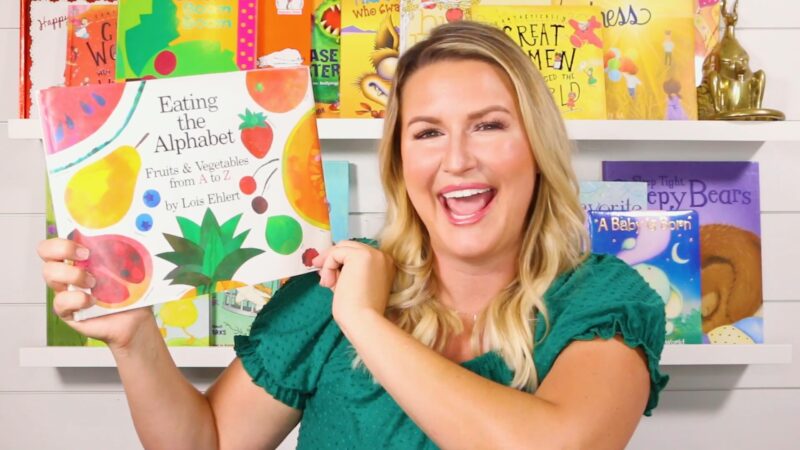
Lois Ehlert’s “Eating the Alphabet” is a delightful journey through the world of fruits and vegetables, arranged from A to Z. This book is a visual feast, with vibrant hand-painted illustrations that will captivate young readers.
Ehlert’s expertise in crafting a narrative is evident in this book. Each page introduces children to a new fruit or vegetable, encouraging them to explore and taste the diverse flavors of the world. As a parent and educator, I’ve seen firsthand how this book can spark curiosity in children, making them eager to try new foods and expand their palates. It’s a must-have for every young reader’s library.
One of the best ways to engage children with this book is to turn it into an interactive experience. After reading, take your child to a local farmer’s market or grocery store and challenge them to find as many fruits and vegetables from the book as possible. This hands-on approach not only reinforces the lessons from the book but also creates lasting memories.
2. Oliver’s Vegetables – By Vivian French
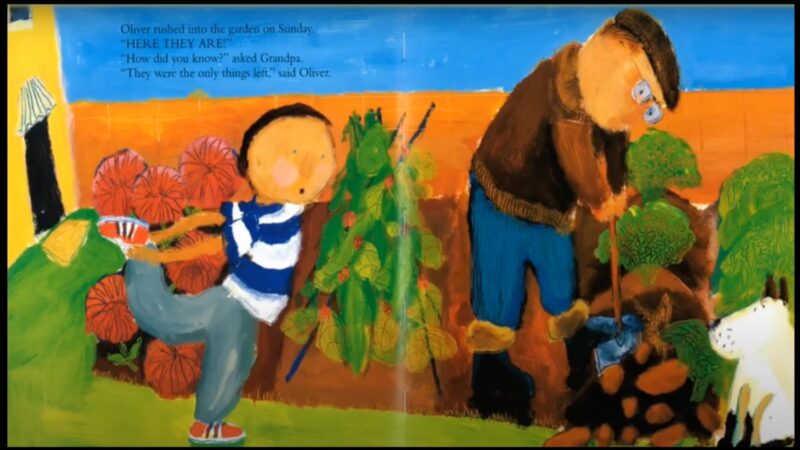
Vivian French’s “Oliver’s Vegetables” is a heartwarming tale of a young boy named Oliver who spends a week with his grandfather. Initially, Oliver only wants to eat potatoes, but as he helps his grandfather in the garden, he discovers a variety of vegetables and learns to appreciate their unique flavors.
The beauty of this book lies in its simplicity. It gently introduces children to the concept of farming and the joy of harvesting one’s own food. The bond between Oliver and his grandfather is beautifully portrayed, emphasizing the importance of family and traditions.
As someone who grew up gardening with my grandparents, this book resonates deeply with me. It’s a gentle reminder of the timeless joys of nature and the bonds we forge while tending to it.
Gardening is a therapeutic activity that offers numerous benefits for children. It teaches them patience, responsibility, and the value of hard work. If you have the space, consider starting a small vegetable garden with your child. If not, container gardening or joining a community garden can be equally rewarding. The joy of watching a seed grow into a plant and then harvesting its produce is unparalleled.
3. The Little Mouse, the Red Ripe Strawberry, and the Big Hungry Bear – By Don Wood
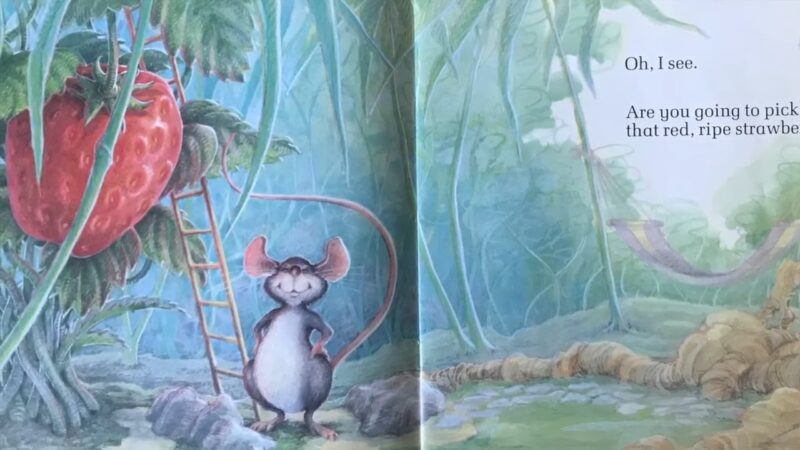
This enchanting tale revolves around a little mouse who finds a red ripe strawberry. However, the mouse faces a dilemma: how to save the strawberry from the big hungry bear. The story is a delightful blend of suspense, humor, and clever solutions.
Don Wood’s illustrations are a visual treat, bringing the story to life with vivid colors and expressive characters. The narrative is engaging, with a rhythmic flow that keeps children hooked from start to finish. As an advocate for creative problem-solving, I appreciate how this book encourages children to think outside the box and find innovative solutions to challenges.
There are many books and even board games that can improve your child’s problem-solving skills, which are essential for your kids development.
Children are naturally curious and imaginative. This book serves as a great tool to foster their problem-solving skills. After reading, engage your child in a discussion about alternative endings or solutions to the mouse’s predicament. Encourage them to draw or write their own version of the story. This not only enhances their creativity but also boosts their confidence in their own ideas.
4. The Vegetables We Eat – By Gail Gibbons
Gail Gibbons offers a comprehensive look into the world of vegetables in “The Vegetables We Eat.” From how they grow to the different ways they can be prepared, this book is a treasure trove of information presented in an engaging and accessible manner.
Gibbons’ knack for simplifying complex topics is commendable. The book categorizes vegetables based on their parts we eat, such as roots, stems, and leaves. The illustrations are detailed, providing a visual aid to the information, making it easier for children to grasp and remember. As someone deeply invested in children’s education, I believe this book is an excellent resource for introducing kids to the science of botany and the importance of nutrition.
One of the most effective ways to reinforce the lessons from this book is through hands-on activities. Consider organizing a vegetable tasting session for your child. Let them touch, smell, and taste different vegetables. Discuss the textures, flavors, and nutritional benefits of each. This sensory experience can be a fun way to explore the world of vegetables and instill healthy eating habits.
5. Two Old Potatoes and Me – By John Coy
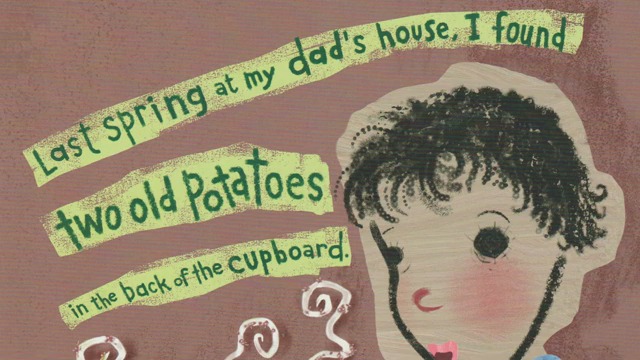
John Coy’s “Two Old Potatoes and Me” is a touching story about a girl who discovers two old, sprouting potatoes in the back of the cupboard. With her father’s guidance, she learns how to plant and nurture them, leading to a bountiful harvest.
The narrative is a testament to the magic of growth and transformation. The story beautifully captures the patience and care required in gardening, and the joy and satisfaction derived from it. The illustrations complement the narrative, depicting the changing seasons and the growth of the potatoes. As someone who cherishes the bond between parents and children, this book highlights the beauty of shared experiences and the lessons they impart.
Gardening projects, like the one depicted in the book, are a fantastic way to bond with your child. It’s not just about growing vegetables; it’s about nurturing a sense of responsibility, understanding the cycle of life, and celebrating small achievements. If you come across old sprouting potatoes or any other vegetable, consider planting them with your child. Document the growth journey through pictures and notes, creating lasting memories.
6. Little Sweet Potato – By Amy Bloom

Amy Bloom’s “Little Sweet Potato” is a heartwarming tale of a little sweet potato who gets knocked out of his patch and embarks on a journey to find his way back home. Along the way, he encounters various plants and vegetables, some kind and some not so much.
The story is a beautiful metaphor for acceptance and belonging. It teaches children the value of self-worth and the importance of kindness and compassion. The vibrant illustrations add depth to the narrative, making the characters and settings come alive. As a firm believer in teaching children about emotional intelligence, I find this book to be a valuable resource in discussing feelings, friendships, and the idea of “home.”
Children often face situations where they feel out of place or different. This book can be a conversation starter about embracing one’s uniqueness and the importance of inclusivity. After reading, engage your child in activities that celebrate diversity, like creating a collage of different vegetables, each with its unique qualities, emphasizing that every vegetable has its place in the garden of life.
7. Little Pea – By Amy Krouse Rosenthal
“Little Pea” is a whimsical tale of a young pea who has a peculiar problem: he dislikes eating candy, much to the amusement of his pea parents. This delightful twist on the age-old challenge of getting children to eat their vegetables is both humorous and insightful.
Amy Krouse Rosenthal masterfully flips the script, presenting a world where vegetables are the desired treat and candy is the dreaded dinner. The playful narrative, paired with charming illustrations, offers a fresh perspective on the topic of food preferences. As someone who has navigated the challenges of picky eating with many young ones, I find this book to be a clever way to address and discuss food choices with children.
Children often go through phases of being selective eaters. Instead of turning mealtime into a battleground, use stories like “Little Pea” to introduce humor and perspective. After reading, engage in a playful role-reversal game where vegetables become the treats and desserts take a backseat. This light-hearted approach can make mealtime more enjoyable and open up discussions about the importance of balanced eating.
8. Eat Your Peas, Louise! – By Pegeen Snow
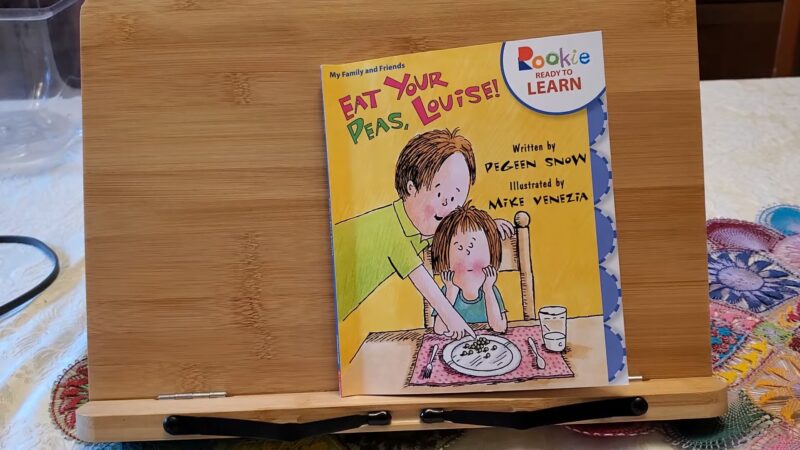
In “Eat Your Peas, Louise!“, young Louise is presented with a plate of peas, a food she staunchly refuses to eat. The story unfolds as her family tries various creative methods to persuade her to give the peas a chance.
Pegeen Snow delves into a familiar scenario many parents and caregivers can relate to. The book is filled with humor, imaginative scenarios, and a subtle message about giving unfamiliar foods a try. The vibrant illustrations add a layer of engagement, making it a favorite during mealtime readings. As someone who values perseverance and adaptability, this book serves as a reminder that sometimes, all it takes is a little creativity and an open mind.
Children often resist certain foods due to unfamiliarity or past experiences. Instead of forcing them, try making the food fun. For instance, after reading “Eat Your Peas, Louise!”, you could create a pea-themed art project or even a pea counting game. Integrating the food into enjoyable activities can reduce resistance and foster a sense of curiosity.
9. Pick, Pull, Snap! – By Lola Schaefer
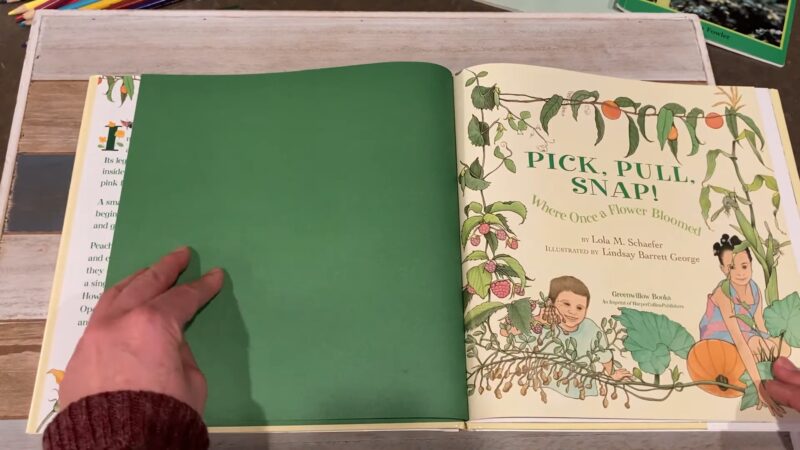
“Pick, Pull, Snap!” by Lola Schaefer is an interactive exploration of where our food comes from. The book delves into the journey of various fruits and vegetables, from their growth on plants and trees to their arrival on our plates.
Schaefer’s approach is both educational and engaging, with flaps that children can lift to discover more about each fruit or vegetable. The detailed illustrations provide a visual treat, making the learning process even more enjoyable. As someone deeply passionate about nature and the environment, I believe it’s crucial for children to understand and appreciate the origins of their food.
One of the most enriching experiences for a child is to see the growth process of their food firsthand. After reading this book, consider planting a small garden or even a single plant with your child. Watching a seed transform into a fruit or vegetable is not only educational but also instills a sense of wonder and appreciation for nature’s miracles.
10. Apples, Cherries, Red Raspberries – By Brian Cleary
Brian Cleary’s “Apples, Cherries, Red Raspberries” is a rhythmic journey through the world of fruits. The book’s catchy rhymes and playful tone make it a delightful read, introducing children to various fruits and their characteristics.
Cleary’s approach is both fun and informative, making learning about fruits an enjoyable experience. The illustrations are bright and cheerful, adding to the book’s appeal. As someone who believes in the power of rhymes and rhythms in early education, this book stands out as a perfect blend of entertainment and knowledge.
Rhymes have a unique way of making information stick. After reading the book, engage your child in a fruit-tasting session. As they taste each fruit, come up with fun rhymes or songs together, celebrating the flavors and textures. This interactive approach not only reinforces the lessons from the book but also enhances memory retention and creativity.
FAQ
Are these books suitable for toddlers?
Yes, most of these books are designed for young readers, including toddlers, with simple text and vibrant illustrations.
How can I encourage my child to try new fruits and vegetables after reading these books?
Pair the reading experience with a tasting session of the fruits or vegetables featured in the book. This hands-on approach can be exciting and educational.
Can these books be used in a classroom setting?
Absolutely! These books are great resources for teachers to introduce topics of healthy eating, nature, and science in an engaging way.
Are there any activities in these books?
While some books may have interactive elements like flaps or pop-ups, you can create your own activities like drawing, gardening, or cooking based on the stories.
Where can I buy these books?
These books are available at most bookstores, online retailers, and in many public libraries.
Are there books for older children on this topic?
Yes, there are books targeted at older children that delve deeper into topics like gardening, cooking, and the science of plants.
Final Words
Nurturing a love for fruits and vegetables in children is a gift that lasts a lifetime. Through captivating stories, vibrant illustrations, and shared experiences, we can instill healthy habits and a deep appreciation for nature’s bounty.
As we turn the pages of these books, we not only feed our children’s minds but also their souls, paving the way for a healthier, brighter future.
